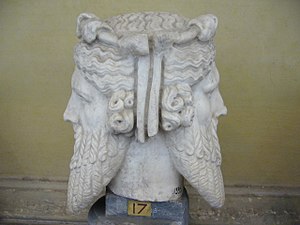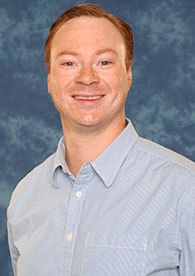Let me begin with a mythological allusion. The Roman god Janus was often depicted with two faces to signify his interstitial nature. He looked into the future and past, and oversaw beginnings and endings. He marked the boundaries between inside and outside. Janus, the gateway god, seems a suitable reference for my polarized reaction to Durham University Senior Lecturer Peter Collins’s interview on “Religion and the Built Environment.”

From one perspective, I was delighted to hear a fascinating discussion of how Collins came to study the built environment early in his career. Using his experience studying an adjacent Quaker meetinghouse and an Anglican church, he demonstrates the many joys of reading the built environment closely. It is obvious, too, that he is productively sharing his skills with his students in the field. Teaching undergraduates the value of examining the built environment is a true service to the academy. We should all be so lucky to have Durham Cathedral or delightfully juxtaposed religious buildings down the road for our students to explore! [This material begins at 11:15 in the interview.]
From another perspective, however, I feel quite at odds with his view that religion and the built environment remains a “field little plowed.” The dissertation I am finishing at the moment in Religious Studies at the University of California, Santa Barbara, for instance, begins with the premise that the built environment has been over-emphasized to the detriment of other modes of creating and maintaining sacred space.While I nodded enthusiastically when he praised Lindsay Jones’s The Hermeneutics of Sacred Architecture. (It is a fascinating and under-utilized two-volume theoretical work.) I confess that I gritted my teeth when he recommend Pierre Bourdieu’s 1971 essay ”The Berber House.” In 2013 we are still falling back on structuralism to look at religious buildings? (Jones, for his part, would probably be shocked.)
However, lest I be uncharitable to a colleague across the Atlantic, I think that my unease may be less disagreement than the simple product of differences in geography, discipline, and the years between our training. Collins is a social anthropologist who specializes in, among many things, Quakerism in 17th and 18th century England. I am a religious studies scholar who specializes in sacred space in the contemporary United States. I am finishing my degree in June, while he has been publishing for over 15 years.
It reminds me somewhat of Hans Rosling’s famous TEDTalk “Let my dataset change your mindset.” Our conceptions about the world, Rosling argued in relation to the division between first and third world, are not shaped by the time we live in, but by the year our teachers were born. Obviously this is overstating the case. 15 years isn’t that long. And academic discourse is not global health. I think it is telling, however, that my own Master’s degree adviser Peter Williams published his bibliographic essay for The Material History of American Religion Project on “The Built Environment of American Religion: The State of the Art”in 1995. He began by saying “Until recently, the study of America’s religious architecture and landscape was something that had largely fallen through the cracks of academe.” Collins similarly says there is very little on the built environment today. It is “fairly sparse” in Anthropology or there is “very little” in the Sociology of religion and only “slightly more prominent” in Religious Studies. I think–although I don’t have elegant charts to make my case–that today this characterization misses the mark.
Perhaps the fundamental challenge to a mighty wave of studies about the built environment, as Collins explores in the interview, occurs when we move beyond defining the critical terms (religion, built environment, material culture, etc.). When we look at the scholarship on the built environment we are forced to consult an ever-widening set of theories and methods. History, Anthropology, Sociology, Religious Studies, Gender Studies, Architectural History, Visual Studies, Literature, and so on all have contributions to the study of the built environment. The list is as broad as the academy itself. Yet, teaching our students the skills necessary to interpret and think critically about the built environment is a significant obstacle.

I also fully agree that a major issue is how easy it is to overlook the built environment all around us. Collins said, rather earthily, that he wondered “if sometimes it is because buildings are so bloody obvious, so huge and so manifest, that we don’t see them.” Isn’t this the very joke from David Foster Wallace’s famous commencement speech?
There are these two young fish swimming along and they happen to meet an older fish swimming the other way, who nods at them and says “Morning, boys. How’s the water?” And the two young fish swim on for a bit, and then eventually one of them looks over at the other and goes “What the hell is water?”
For Collins, the environment is humanity’s water. It is “all of that which exists outside of the human being,” and it includes those elements that humans build. If we want to be sensitive to it, then we must cultivate sensibilities that make it visible and legible. Since the scholarship surrounding the built environment comes from across the academy, it can be a tangle of interdisciplinary webs. Structuralism of the type Bourdieu presents in “The Berber House,” I would be the first to confess, can be a way to untangle this web or even avoid it altogether.
Collins later wonders why, when speaking about Jones’ comparative architectural model, so little has been done with it. If you brave Jones’s volumes, you will understand why. It is terrifically complex. It is also not something that can be presented without modification to undergraduates. [Jones is discussed in the final 15 minutes or so of the interview.] Nevertheless, its presence here is an indication that the conversation may be evolving in ways that will promote its use in the future.
We are still confronting the double challenges of interdisciplinary expansion and, shall we say, legibility or transferability to our students and the public. The close-reading of the Quaker meetinghouse that Collins offers is a strong demonstration that the rewards of overcoming these challenges are high. I can contribute to these rewards by recommending a few recent titles that deal with the built environment in satisfying and novel ways. A comprehensive list, such as that offered by Williams above, is probably not possible without first retreating bookishly to the corners of the academy where our own disciplines lie. In that respect, the few items in my bibliography reflect my contemporary American biases. I also take “built environment” to indicate much more than simply religious buildings. This is a product not merely of my research in spatial theory and place studies, but of my interests in expanding the study of sacred space beyond the walls of the church. I encourage everyone to continue the discussion and add their own favorite recent items on religion and the built environment in the comments.
Selected Bibliography on Religion and the Built Environment since 1990
- Chidester, David, and Edward T. Linenthal, eds. American Sacred Space. Edited by Catherine L. Albanese and Stephen J. Stein, Religion in North America. Bloomington: Indiana University Press, 1995.
- Diamond, Etan. And I Will Dwell in Their Midst: Orthodox Jews in Suburbia. Chapel Hill: The University of North Caronlina Press, 1999.
- Eiesland, Nancy L. A Particular Place: Urban Restructuring and Religious Ecology in a Southern Exurb. New Brunswick, NJ: Rutgers University Press, 2000.
- Farmer, Jared. On Zion’s Mount: Mormons, Indians, and the American Landscape. Cambridge, MA: Harvard University Press, 2008.
- Francaviglia, Richard V. Believing in Place: A Spiritual Geography of the Great Basin. Reno & Las Vegas: University of Nevada Press, 2003.
- Griffith, James S. . Beliefs and Holy Places: A Spiritual Geography of the Pimeria Alta. Tucson: University of Arizona Press, 1992.
- Jones, Lindsay. The Hermeneutics of Sacred Architecture: Experience, Interpretation, Comparison. 2 vols, Religions of the World. Cambridge, MA: Distributed by Harvard University Press for Harvard University Center for the Study of World Religions, 2000.
- Kieckhefer, Richard Theology in Stone: Church Architecture From Byzantium to Berkeley. London: Oxford University Press, 2008.
- Kilde, Jeanne Halgren. When Church Became Theatre: The Transformation of Evangelical Architecture and Worship in Nineteenth-Century America. Oxford ; New York: Oxford University Press, 2002.
- Kerstetter, Todd M. God’s Country, Uncle Sam’s Land: Faith and Conflict in the American West. Urbana and Chicago: University of Illinois Press, 2006.
- Lane, Belden C. Landscapes of the Sacred: Geography and Narrative in American Spirituality. Expanded ed. Baltimore: Johns Hopkins University Press, 2001.
- Linenthal, Edward T. Sacred Ground : Americans and Their Battlefields. Urbana: University of Illinois Press, 1991.
- Linenthal, Edward T. The Unfinished Bombing: Oklahoma City in American Memory. Oxford: Oxford University Press, 2001.
- Livezey, Lowell W., ed. Public Religion and Urban Transformation: Faith in the City. Edited by Peter J. Paris, Religion, Race, and Ethnicity. New York: New York University Press, 2000.
- Loveland, Anne C. and Otis B. Wheeler. From Meetinghouse to Megachurch: A Material and Cultural History. St. Louis: University of Missouri Press, 2003.
- Mazur, Eric Michael and Kate McCarthy, ed. God in the Details: American Religion in Popular Culture. New York: Routledge, 2001.
- McDannell, Colleen. Material Christianity: Religion and Popular Culture in America. New Haven: Yale University Press, 1995.
- McGreevy, John T. Parish Boundaries: The Catholic Encounter with Race in the Twentieth-Century Urban North. Chicago: The University of Chicago Press, 1998.
- Metcalf, Barbara Daly, ed. Making Muslim Sacred Space in North American and Europe. Berkeley: University of California Press, 1996.
- Meyer, Jeffrey F. . Myths in Stone: Religious Dimensions of Washington, D.C. Berkeley: University of California Press, 2001.
- Moreton, Bethany. To Serve God and Wal-Mart. Cambridge, MA: Harvard University Press, 2009.
- Nelson, Louis P. American Sanctuary: Understanding Sacred Spaces. Bloomington: University of Indiana Press, 2006.
- Orsi, Bob, ed. Gods of the City: Religion and the American Urban Landscape. Bloomington: Indiana University Press, 1999.
- Sheldrake, Philip. Spaces for the Sacred: Place, Memory, and Identity. Baltimore, MD: The John Hopkins University Press, 2001.
- Treviño, Roberto R. The Church in the Barrio: Mexican American Ethno-Catholicism in Houston. Chapel Hill: University of North Carolina Press, 2006.
- Tweed, Thomas A. America’s Church: The National Shrine and Catholic Presence in the Nation’s Capital. London: Oxford University Press, 2011.
- Tweed, Thomas A. Our Lady of the Exile: Diasporic Religion at a Cuban Shrine in Miami. Oxford: Oxford University Press, 1997.
- Williams, Peter W. Houses of God: Region, Religion, and Architecture in the United States. Edited by Conrad Cherry, Public Expressions of Religion in America. Urbana: University of Illinois Press, 1997.
- Wilford, Justin G. Sacred Subdivisions: The Postsuburban Transformation of American Evangelicalism. New York: New York University Press, 2012.
- Winston, Diane. Red-Hot and Righteous: The Urban Religion of the Salvation Army. Cambridge, MA: Harvard University Press, 1999.
- Upton, Dell. Holy Things and Profane: Anglican Parish Churches in Colonial Virginia. New Haven, CT: Yale University Press, 1997.
- Zepp, Jr., Ira G. The New Religious Image of Urban America: The Shopping Mall as Ceremonial Center. 2nd ed. Boulder: University Press of Colorado, 1997.



